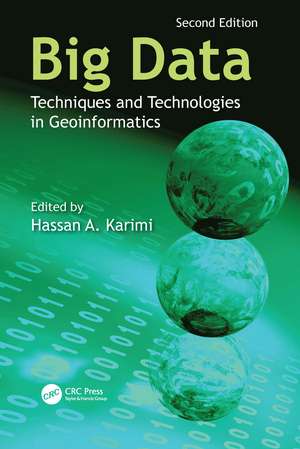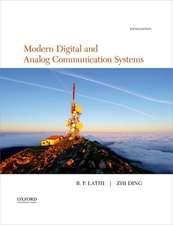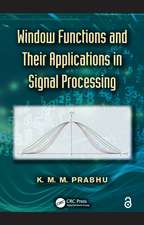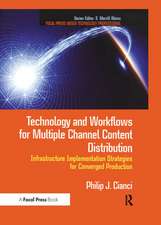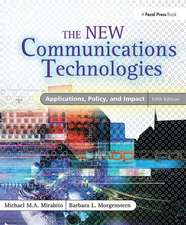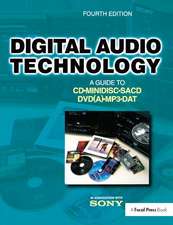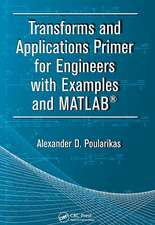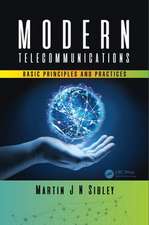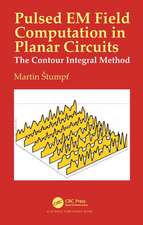Big Data: Techniques and Technologies in Geoinformatics
Editat de Hassan A. Karimien Limba Engleză Hardback – aug 2024
FEATURES
- Contains a comprehensive collection of advanced big data approaches, techniques, and technologies for geoinformatics problems
- Provides seven new chapters on deep learning models, algorithms, and structures, including a new chapter on how spatial metaverse is used to build immersive realistic virtual experiences
- Presents information on how deep learning is used for solving real-world geoinformatics problems
| Toate formatele și edițiile | Preț | Express |
|---|---|---|
| Paperback (1) | 436.09 lei 6-8 săpt. | |
| CRC Press – 29 mar 2017 | 436.09 lei 6-8 săpt. | |
| Hardback (2) | 1086.31 lei 6-8 săpt. | |
| CRC Press – 18 feb 2014 | 1086.31 lei 6-8 săpt. | |
| CRC Press – aug 2024 | 1176.28 lei 6-8 săpt. |
Preț: 1176.28 lei
Preț vechi: 1470.36 lei
-20% Nou
Puncte Express: 1764
Preț estimativ în valută:
225.15€ • 244.65$ • 189.25£
225.15€ • 244.65$ • 189.25£
Carte tipărită la comandă
Livrare economică 21 aprilie-05 mai
Preluare comenzi: 021 569.72.76
Specificații
ISBN-13: 9781032525143
ISBN-10: 1032525142
Pagini: 409
Ilustrații: 366
Dimensiuni: 178 x 254 mm
Greutate: 0.93 kg
Ediția:2
Editura: CRC Press
Colecția CRC Press
Locul publicării:Boca Raton, United States
ISBN-10: 1032525142
Pagini: 409
Ilustrații: 366
Dimensiuni: 178 x 254 mm
Greutate: 0.93 kg
Ediția:2
Editura: CRC Press
Colecția CRC Press
Locul publicării:Boca Raton, United States
Public țintă
Academic, Postgraduate, Professional Practice & Development, and Undergraduate AdvancedCuprins
1. Distributed and Parallel Computing. 2. GEOSS Clearinghouse Integrating Geospatial Resources to Support the Global Earth Observation System of Systems. 3. Using a Cloud Computing Environment to Process Large 3D Spatial Datasets. 4. Building Open Environments to Meet Big Data Challenges in Earth Sciences. 5. Developing Online Visualization and Analysis Services for NASA Satellite-Derived Global Precipitation Products during the Big Geospatial Data Era. 6. Algorithmic Design Considerations for Geospatial and/or Temporal Big Data. 7. Machine Learning on Geospatial Big Data. 8. Spatial Big Data: Case Studies on Volume, Velocity, and Variety. 9. Exploiting Big VGI to Improve Routing and Navigation Services. 10. Efficient Frequent Sequence Mining on Taxi Trip Records Using Road Network Shortcuts. 11. Geoinformatics and Social Media: New Big Data Challenge. 12. Insights and Knowledge Discovery from Big Geospatial Data Using TMC-Pattern. 13. Geospatial Cyberinfrastructure for Addressing the Big Data Challenges on the Worldwide Sensor Web. 14. OGC Standards and Geospatial Big Data. 15. Advanced Deep Learning Models and Algorithms for Spatial-Temporal Data. 16. Deep Learning for Spatial Data: Heterogeneity and Adaptation. 17. Assessing Multilevel Environmental and Air Quality Changes in Australia Pre- and Post-COVID-19 Lockdown: A Spatial Machine Learning Approach Utilizing Earth Observation Data. 18. Fairness-Aware Deep Learning in Space. 19. Integrating Large Language Models and Qualitative Spatial Reasoning. 20. Toward a Spatial Metaverse: Building Immersive Virtual Experiences with Georeferenced Digital Twin and Game Engine. 21. A Topological Machine Learning Approach with Multichannel Integration for Detecting Geospatial Objects.
Notă biografică
Hassan A. Karimi is a Professor and the Director of the Geoinformatics Laboratory in the School of Computing and Information at the University of Pittsburgh. He earned a PhD in geomatics engineering at the University of Calgary. Dr. Karimi’s research interests include computational geometry and topology, machine learning, spatial data analytics, navigation techniques and applications, location-based services, mobile computing, and distributed/parallel computing. His research in geoinformatics has resulted in over 230 publications in peer-reviewed journals and conference proceedings, as well as in many workshops and presentations at national and international forums. Dr. Karimi has published the following books with Taylor & Francis: Geospatial Data Science Techniques and Applications (2018), Indoor Wayfinding and Navigation (2015), Big Data: Techniques and Technologies in Geoinformatics (2014), Advanced Location-Based Technologies and Services (2013), CAD and GIS Integration (2010), and Telegeoinformatics: Location-Based Computing and Services (2004). He has published Universal Navigation on Smartphones (2011) with Springer and Handbook of Research on Geoinformatics (2009) with IGI.
Descriere
This revised new edition provides up-to-date knowledge on the latest developments related to these three fields for solving geoinformatics problems. There are seven new chapters, and each of them focuses on a separate real-world problem to which deep learning is applied.
